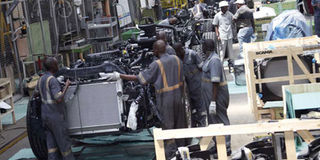Breaking News: At least 10 feared to have drowned in Makueni river
It’s prudent to invest in manufacturing

Vehicles being assembled at Associated Vehicle Assembly in Jomvu, Mombasa County, on January 24, 2018. PHOTO | LABAN WALLOGA | NATION MEDIA GROUP
What you need to know:
- Because it supports productive investments, manufacturing enables high savings rates.
- Technological advancement is concentrated in manufacturing and then diffuses to other sectors — that is, machines make machines.
Manufacturing has the potential to spark productivity more than any other sector in the economy.
It is important to note that, contrary to common perceptions, manufacturing does not ‘compete’ with other industries such as the services sector; rather, it is an ‘enabler’ for productivity for all the other sectors.
For starters, it has been proven that, as long as the share of manufacturing to gross domestic product (GDP) is rising, similarly, the per capita growth rate (which reflects average incomes) continues to rise.
This is what economists refer to as “structural change bonus”.
CAPITAL
However, if we reduce the resources towards investment in manufacturing in favour of, say, services, we risk experiencing a structural change burden — which is the opposite of the bonus — because we rely on a sector whose capacity does not support the required increase in productivity.
It is true that few services, for instance, transport, distribution and information and communication technology (ICT), which are linked to markets, have the potential for productivity.
However, in order to have, and sustain, a thriving market, an economy needs to have a strong manufacturing base, which supports agriculture and quality production of goods.
Secondly, manufacturing and agriculture are interlinked; each depends on the success of the other to grow.
Manufacturing creates opportunities for capital accumulation more than agriculture.
This means that companies in industry, be it small, medium or large, can invest in diverse assets and to increase capital flow.
SAVINGS
Additionally, the returns to capital in manufacturing are higher than in other sectors.
Because it supports productive investments, manufacturing enables high savings rates.
Moreover, you will find that, typically, investment spending is channelled towards manufactured goods such as machinery, equipment and building material.
Capital intensity is also high in manufacturing and activities generated by manufacturing, for instance, construction and transport; however, the same is lower in sectors such as agriculture and services.
TECHNOLOGY
Manufacturing also offers opportunities for economies of scale.
The United Nations Economic Commission for Africa (ECA) has stated that manufacturing is especially important in advancing technologies in many societies due to “its leading role in diffusing technological progresses”.
Technological advancement is concentrated in manufacturing and then diffuses to other sectors — that is, machines make machines.
The development of gadgets, gizmos, tools and equipment used to drive productivity and efficiency in other sectors rides on the back of advanced manufacturing.
INCOME
Backward and forward linkages are also stronger in manufacturing than other sectors.
From growing and harnessing raw materials to processing, treatment, packaging, transporting, repackaging, storage and distribution, all these are actors in the value chain anchored on manufacturing.
Subsequently, the spillover effects of manufacturing activity, for instance, technologies and skills, are stronger compared to other sectors.
These effects also spread between other sectors as well.
Lastly, when per capita income rises, the share of expenditure on manufactured goods increases.
AGRICULTURE
In contrast, in the context of total expenditure, the share of agriculture expenditure decreases due to low income elasticity.
By this I mean if the household income changes, the demand for certain products drops.
Essentially, countries that rely on agriculture will need to industrialise in order to profit from expanding to local and global markets.
Some have argued that expenditure on services does grow, as per capita income increases, akin to manufacturing.
It is true that the expenditure on services might grow but, contrary to the case of manufacturing, the growth of expenditure here is only a result of increased income, not increased productivity.
'BIG FOUR' AGENDA
Manufacturing will guarantee the latter and, in the long run, offer more sustainability in terms of economic growth.
These are just a few examples of why many countries focus their resource and investment towards growing the manufacturing sector.
It only makes sense that manufacturing is one of the pillars of the ‘Big Four’ agenda.
However, to truly realise our economic goals, our focus in manufacturing must be long-term and centred on all our development plans.
Ms Wakiaga is the CEO of Kenya Association of Manufacturers and the UN Global Compact Network representative for Kenya. [email protected].





